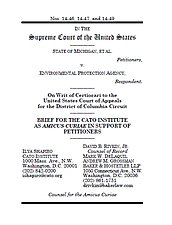Michigan v. EPA
Learn more about Cato’s Amicus Briefs Program.
The Supreme Court has resolved to answer whether it was unreasonable for the Environmental Protection Agency to ignore the costs of its actions when it decided that it was “appropriate” to subject power plants to burdensome regulation under Section 112 of the Clean Air Act. That’s an easy one: Of course it was. But there’s a more interesting question: why would the EPA choose to ignore costs? The answer is that it didn’t have much of a choice if it wanted to achieve its longstanding goal of regulating utility-sector emissions free from the limitations of other Clean Air Act programs. Its stated basis for choosing to regulate—the hazard of power plants’ mercury emissions—have basically no impact on human health because they constitute little more than a drop in the sea of global emissions. In fact, to identify any conceivable risk at all, the agency had to assume the existence of “women of child-bearing age in subsistence fishing populations who consume freshwater fish that they or their family caught” in enormous quantities, thereby boosting their mercury exposure. Even then the agency had to put its thumb on the scale at every step. And on the other side of the scale? Annual costs of nearly $10 billion. So weighing costs against benefits would have ruled out Section 112 regulation, leaving EPA limited in its ability to target coal-fired power plants directly, due to the cooperative-federalism structure of the Clean Air Act. But ignoring costs and proceeding under Section 112—even if there’s no real basis for it—allows the EPA to circumvent the Act’s design and take aim at a mode of power generation disfavored by the Obama administration. This is a familiar story: a federal agency twisting statutory language to aggrandize itself beyond what the law allows at the expense of the states. The Supreme Court should swat down this power grab.

This work is licensed under a Creative Commons Attribution-NonCommercial-ShareAlike 4.0 International License.
